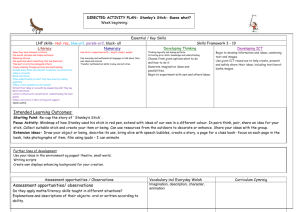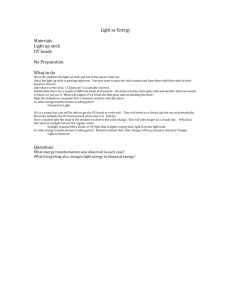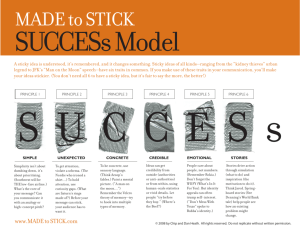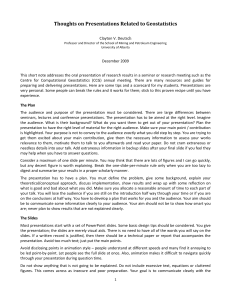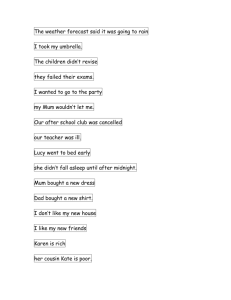Making Your Presentation Stick
advertisement
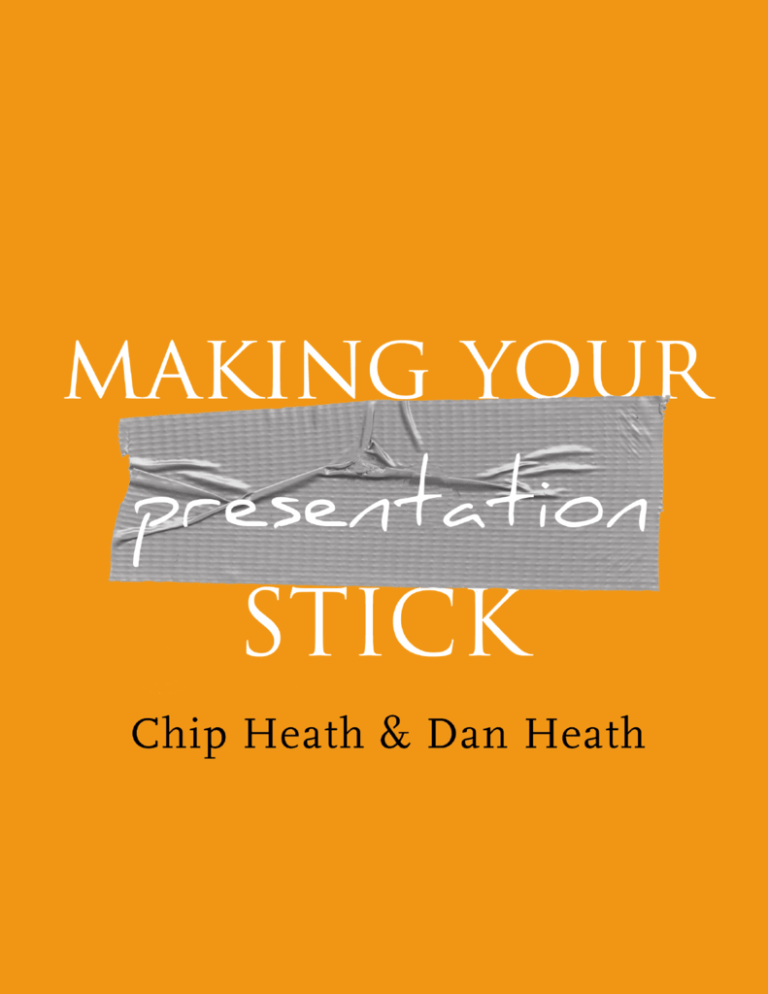
Making Your Presentation Stick Y ou can’t talk about sticky ideas without talking about presentations. Although most of us dread presentations, pause for a moment and think about the advantages you have when you’re making a presentation. Unlike a journalist who is trying to get a reader to read an article, or an advertiser who’s trying to stand out in a crowded market, or a parent who’s trying to shout a message to a teen who is running to a friend’s house, you’ve got it made: You’ve received an invitation to make an idea stick. You have a dedicated slice of time and an audience willing to sit still. That’s a precious opportunity. How do you make the most of it? We believe there are a few basic rules that should govern any kind of presentation, whether you’re selling a product to a customer, or training a new employee, or discussing your church’s outreach program, or explaining the Smoot-Hawley Tariff Act. 1. Stories and examples are the building blocks of a presentation If you use only one tip, this is the one. The #1 mistake we’ve observed in presentations—and there is no close second—is that the message is too abstract. The presenter offers concepts and conclusions but not evidence. He talks at a high level about the big picture, but gives no concrete details that might make the big picture understandable and plausible. He may sprinkle in a few stories or examples, but they are treated like garnish. Most people communicate with, say, 3 parts exposition to 1 part example. That’s exactly backwards. In a compelling presentation, examples aren’t garnish, they’re the entrée. A presentation is a sequence of concrete examples and stories that snap together to form a compelling argument. For instance, think of the examples that Al Gore used in his movie An Inconvenient Truth: The before and after photos of Mt. Kilimanjaro, showing the vanishing snow caps. The simulated satellite images of Manhattan flooded by rising sea levels. In Michael Moore’s Sicko, he doesn’t make conceptual points about the health care system—he makes his case through the stories of individuals, like the carpenter who accidentally cut off 2 fingers, and then had to choose which finger to reattach since he couldn’t afford to do both! A social enterprise called VisionSpring provides eyeglasses to the poor. There are hundreds of millions of people in the developing world who need glasses. But when the founder of VisionSpring makes a presentation to potential donors, he is careful to tell the stories of individuals. For instance, he’ll talk about a 35 year-old weaver in India— a master craftsman with 20 years of experience. He earns a good living for his family and uses some of his income to send his kids to school. Then, as his eyesight begins to degenerate (as everyone’s does at that age), he finds himself increasingly unable to accomplish the “up-close” work that’s the heart of weaving. He simply can’t see well enough. He begins to rely on his children to help, which means they miss days at school. As his eyesight deteriorates further, his income suffers and he becomes increasingly reliant on his wife and kids to supplement it. Here’s a man who is at the height of his skills but can no longer provide for his family—and the solution is as simple as a generic pair of reading glasses, the kind that you and I could buy at a drug store for $5! Without understanding that story, you can’t appreciate the full value of what VisionSpring does. We know many of you have to present data in your presentations. But because data is pretty abstract, you should resist your temptation to lead with the data or to let the data stand alone. Which is more compelling? Saying that there are “900,000 poor adults with declining eyesight in Mumbai, and we need your help to start solving the problem.” Or telling the story above about the 35-year-old weaver, and then saying, “Our research suggests that there are 900,000 stories like this, in Mumbai alone, and we need your help to start solving the problem.” Data are just summaries of thousands of stories—tell a few of those stories to help make the data meaningful. For more on this point, we strongly recommend the story in Made to Stick about Gary Klein’s attempt to capture the takeaways of a conference. See pages 235-237. And consider how Stephen Denning used stories to change the attitude of his colleagues at the World Bank toward “knowledge management” on pages 231-235. 2. Don’t preamble, parachute in The first mission of a presentation is to grab attention. And that’s why it’s disturbing that many presentations stumble out of the gate with a preamble—a laborious overview of what’s going to be covered. This problem is understandable. After all, we’ve all been coached to “Tell ‘em what you’re gonna tell ‘em, then tell ‘em, then tell ‘em what you told ‘em.” Making Your Presentation Stick 1 But that advice is overstructured and, frankly, unnecessary. Steve Jobs doesn’t present this way. Ronald Reagan didn’t present this way. Toss out the preamble and parachute into the action. Rebecca Fuller was giving a critical presentation to a group of museum directors. Fuller is the founder of RAF Models, a group that creates tactile museum exhibits, such as landscapes for history museums that guests can touch. Her tactile exhibits are particularly great for visually impaired guests. Fuller wanted to help the museum directors see how important it is to push beyond visual-only exhibits. So she started the presentation with a bang: She had a colleague kill the lights, abruptly, leaving the presentation room in darkness. Fuller said, This is what it’s like to be a blind person in most museums. There’s nothing to learn, nothing to experience, because all the good stuff is in a medium that is off limits to you. Within seconds of starting her presentation, she has focused her audience’s attention on the problem she wants to solve. But it shouldn’t. Think about yourself as the director of a play, and you’re allocating speaking parts among your main points. You can create a great monologue or a great dialogue, but if you’ve got 22 characters speaking, you haven’t developed any of them properly. So don’t dwell on the pain of cutting the bullet point on slide 17, think about the extra attention you’ve allocated to your main characters. A vice-president of a large department-store chain was leading an effort to help front-line store managers reclaim their time from unnecessary tasks and procedures. He had plenty of examples to discuss, but he wisely decided to focus his presentation by highlighting the single most glaring example of wasted work: Kicking off his presentation, he slapped down on the conference table an unruly stack of paperwork (519 pages of it). And then he announced, to the horror of his superiors, “This is 2 weeks worth of the audit documentation that’s required of our stores. … You’ve all heard the phrase that the road to hell is paved with good intentions? Well, this is the road to hell.” When Scott Cook was leading the road show for his firm Intuit, he used to start by asking his audience a question: How many of you balance your own checkbooks? Lots of hands would go up. Then he’d ask, OK, how many of you enjoy it? And all the hands would go down. In less than a minute, he’d established the core value proposition of Quicken, Intuit’s top product. Are you giving the spotlight to your most important points? Here are two quick tests: What percentage of your speaking time is going to those points? And what percentage of your slides are dedicated to them? If you’re not spending at least half of your time and your visuals on the core of your message, you’re probably trying to accomplish too much. Clearly neither of these presentations would have been improved with a warm-up. “Today I’m going to give you an overview of the challenges faced by the visually impaired in visiting museums.” “I’d like to begin today, by indulging in a brief survey of existing techniques for financial planning.” If you bring us face-to-face with the problem, we won’t need a lot of upfront hand-holding. For more on prioritizing your main points, take a look at the Simple chapter of Made to Stick and think about how journalists learn to highlight the leads of their stories. For more on grabbing attention, see the Unexpected chapter of Made to Stick, and review the story of the high school journalism teacher whose first lesson was still vivid in his students’ minds two decades after graduation. Or see p. 120-123 for an unexpected pitch by an entrepreneur that lined up millions in venture capital. 3. Let your main points hog the spotlight If you say 10 things, you say nothing. You probably agree with that statement, and yet it’s a hard rule to live by! You’ve put a ton of research into your presentation—you’ve done the research, you’ve analyzed the data, you’ve struggled with the conclusions. All of it seems important. Cutting that third bullet point on slide 17 feels like a wound. 2 Making Your Presentation Stick 4. Tease, Don’t Tell Before your audience will value the information you’re giving, they’ve got to want it. Demand has to come before supply. Most presenters take the audience’s desire for granted, but that’s a big mistake. Great presentations are mysteries, not encyclopedia entries. An online video called “The Girl Effect” starts by recounting a list of global problems: AIDS. Hunger. Poverty. War. Then, it asks, What if there was an unexpected solution to this mess? Would you even know it if you saw it? The solution isn’t the Internet. It’s not science. It’s not government. Curious? See, it works. (Go to girleffect.org for the answer.) Curiosity must come before content. Imagine if the TV show Lost had begun with an announcement: “They’re all dead people and the island is Purgatory. Over the next 4 seasons, we’ll unpack how they got there. At the end we’ll take questions.” We’ve all had the experience of being in the audience as a presenter clicks to a slide with 8 bullet points. As he starts discussing the first bullet point, we quickly read all 8. Now we’re bored. He’s lost us. But what if there had been 8 questions instead? We’d want to stay tuned for the answers. The “teases” don’t need to be particularly dramatic. For instance, David Foster of St. Timothy’s Episcopal Church in Mountain View, CA was asked to make a presentation on the church’s finances. Usually, not many people show up to the meetings. So Foster tried something different. He put a quiz in the church newsletter the week before the meeting, in hopes of sparking some curiosity. He asked questions like these: 1. How much does St. Timothy’s spend to host coffee-hour after services in a year? (a) $3,500; (b) $8,000; (c) $8,750; (d) $9,250 2. If income and expenses are on track with the budget, at the end of the year, we will have: (a) a large surplus; (b) a large deficit; (c) break even; (d) a small deficit. Foster says attendance more than doubled this year, despite it being a year with no major financial news to report (i.e., a budget crisis). A little teasing goes a long way. The best presenters don’t structure their presentations by thinking, “What’s the next point I should make?” Instead, they decide, “What’s the next question I want them to wrestle with?” For more on sparking curiosity, see the discussion of “curiosity gaps” in the Unexpected chapter of Made to Stick. 5. Bring Reality In the Room You may be tempted to stress out about the look and feel of your presentation. At some point, all of us have surfed the web obsessively looking for the perfect image to reinforce our point. At midnight, you call over your spouse to weigh in: “Honey, which one better says ‘innovation’? The bunny coming out of the magician’s hat or the smiley guy with a lightbulb over his head?” Relax. We need to end once and for all the cult of clip art, as well as the splinter church of stock photography. “Show, don’t tell” doesn’t mean that you take your slide about “thinking globally” and add a clip-art world map. That’s decoration, not communication. A good idea doesn’t need visual drapes. When James Carville said, “It’s the economy, stupid,” he didn’t pause to send his direct reports out looking for pictures of dunce hats. (“Sorry, James, we couldn’t find a dunce hat, but is a kid drooling on his desk ‘stupid’ enough?”) “Show, don’t tell” can be easier than it sounds. Just bring a little reality into the room. Tom Duncan, the president of the U.S. division of Positec Power Tool Group, had a sales call last year with a key account. At the last minute, he abandoned his PowerPoint presentation, filled with a predictable homage to the virtues of his tools. Instead, he set two drills on the table—his and his competitor’s. Hedisassembled them side-by-side to show the durability of his company’s design. The customer’s reaction to this surprising dose of reality (and absence of PowerPoint slides)? “He loved it,” Duncan says, and he closed the deal. Brian Leinbach, the EVP Systems Development for Macy’s Systems and Technology, was arguing that Macy’s need to improve its inventory tracking systems. He said that when you go into Nordstrom, if you find something that you like that they don’t have in your size (say a pair of shoes or a belt), they have an easy way of finding it on their systems for you and having it home-delivered. At Macy’s, it’s more complicated. There are 3 different inventory-tracking systems: One for the store you’re in, another for other nearby stores, and a third for Macys.com. To help a customer, you’ve got to look in all three places. And here’s the critical part: While Leinbach was talking, he showed screenshots of the three different interfaces to demonstrate the inelegance of this process. He made it possible for the audience to empathize with the sales rep on the floor. That’s powerful. Leinbach brought reality in the room. Neither Duncan nor Leinbach worried about clip art. Clip art will always be a metaphor for reality (i.e., the lightbulb as “innovation”). Why not go straight to reality? For more on bringing reality in the room, see the Concrete chapter of Made to Stick. One example: Think about how James Grant convinced heads of state to change their country’s health policies by using a simple prop. “Making Your Presentation Stick” is an article written by Chip Heath and Dan Heath, the authors of the book Made to Stick: Why Some Ideas Survive and Others Die, published by Random House in January 2007. Some of the material in this article comes from Made to Stick. Chip Heath (chip@madetostick.com) and Dan Heath (dan@madetostick.com) are the authors of the book Made to Stick: Why Some Ideas Survive and Others Die. They blog at http://www.madetostick.com/blog. Copyright © 2008 by Chip Heath and Dan Heath “Making Your Presentation Stick” was published on October 20, 2008. Making Your Presentation Stick 3


